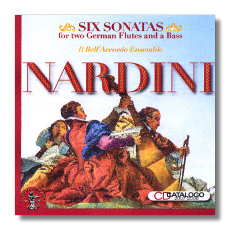
The Internet's Premier Classical Music Source
Related Links
- Nardini Reviews
- Latest Reviews
- More Reviews
-
By Composer
-
Collections
DVD & Blu-ray
Books
Concert Reviews
Articles/Interviews
Software
Audio
Search Amazon
Recommended Links
Site News
 CD Review
CD Review
Pietro Nardini

Six Sonatas for Two German Flutes and a Bass
Il Bell'Accordo Ensemble
Discantica 156 DDD 70:02
Today, Pietro Nardini (1722-1793) is slightly less famous than his teacher Giuseppe Tartini, who spent most of his career in Padua, and who today is remembered chiefly for his so-called "Devil's Trill" Sonata. Both men were acclaimed violinists, and sometimes it is said that their virtuosity paved the way for Paganini. Leopold Mozart heard Nardini play the violin, and praised the beauty of his tone. (Apparently he and Tartini made the greatest impact in slow movements.) In 1770, Nardini was given a position with the Grand Duke of Tuscany in Florence, and it was in that city that he died 23 years later.
Like Leopold Mozart, Nardini straddled the Baroque and early Classical eras. (He was only three years younger than Leopold, and he outlived Wolfgang Mozart by two years.) This is reflected in Nardini's music, which is galant, charming, well-formed, and unfailingly enjoyable. (The grouping of similar works into a set of six also is typical of the Baroque period.) The present performers admit that their use of a harpsichord in the basso continuo is less historically correct than a fortepiano would have been, but more appropriate to the music's Baroque spirit. I have copied the title of the CD exactly as it is given on the cover. By "a Bass," I assume the musicians mean basso continuo. (The harpsichord is joined by a cello, so there is no "Bass," per se.) What is meant by "German flutes" is not so clear. I assume this is another way of saying "transverse flutes made in Austria, perhaps after a German design." (There's nothing inherent "German" about their sound, as far as I can tell.)
These six works – trio sonatas, in essence – are in three movements. Sometimes the slow movement (although never slower than Andante) comes first, and at other times it comes in the middle. The use of two flutes creates some very agreeable sonorities. Although the law of diminishing returns applies when one hears all six sonatas in one sitting, even then, this is just the sort of CD to enjoy after a hard day at work, perhaps while one is soaking in the bathtub, or enjoying a glass of red wine!
The Ensemble's two flutists are Gabriele Formenti (who also acts as "maestro di concerto") and Giona Saporiti. The cellist is Gioele Gusberti, and the harpsichordist is Gabriele Toia. The playing is relaxed and smooth – neither anonymous, nor so "interpreted" that it calls attention to itself. Nardini's gentle gifts deserve these dedicated, gentle performers. One wishes only that the booklet note had more to say about the composer and the music. The engineering is intimate.
Copyright © 2007, Raymond Tuttle












